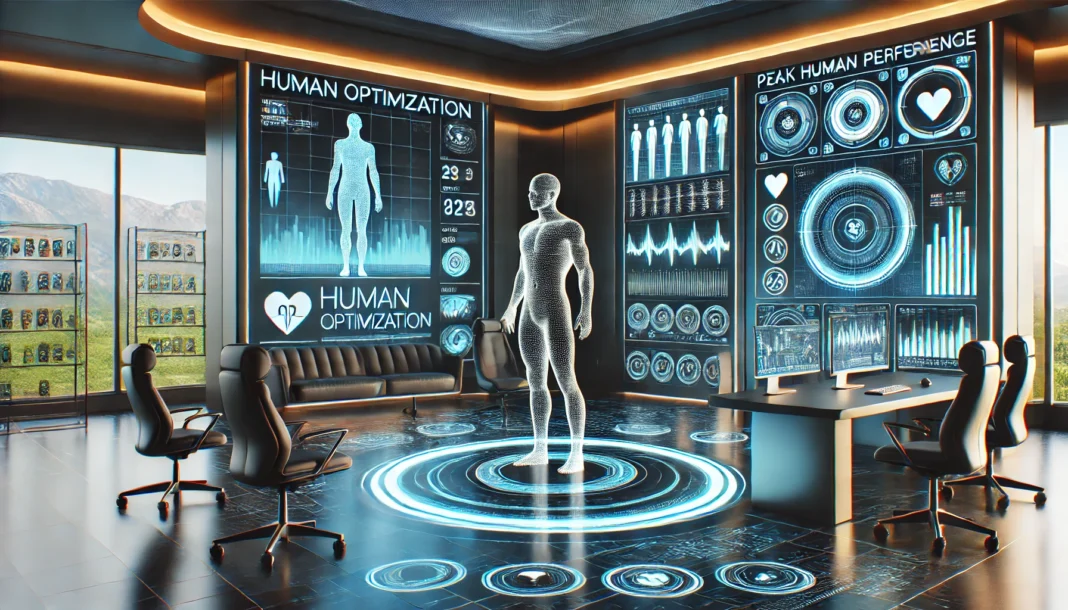Exploring the Meaning and Definition of Biohacking
Biohacking is an emerging field that merges science, technology, and human biology to enhance performance, longevity, and overall well-being. At its core, biohacking involves making incremental changes to one’s body, mind, and environment to optimize biological functions. These modifications can range from simple lifestyle changes, such as diet and exercise adjustments, to more complex interventions, including genetic engineering and the use of wearable technology. Understanding the biohacking definition requires examining its various subfields, which encompass everything from dietary modifications to cutting-edge medical innovations. The question of what does biohacking mean has gained prominence in recent years as more individuals seek alternative ways to improve health beyond conventional medical practices.
You may also like: Biohacking for Beginners: 4 Powerful Ways To Boost Physical and Cognitive Performance
One of the primary goals of biohacking is to gain greater control over one’s biology. This control can be achieved through strategic interventions that improve cognitive function, enhance sleep quality, boost metabolism, and increase physical endurance. The concept of biohacking health extends beyond physical well-being, encompassing mental clarity, emotional resilience, and overall quality of life. As a result, biohackers often experiment with various methodologies, such as intermittent fasting, supplementation, and environmental modifications, to determine what works best for their unique physiology.
The Role of Diet in Biohacking: Understanding the Biohacking Diet
Nutrition plays a fundamental role in biohacking, as dietary choices directly influence energy levels, cognitive function, and metabolic health. The biohacking diet is not a one-size-fits-all approach but rather a personalized strategy designed to optimize nutrient intake and support the body’s biological processes. Many biohackers adopt dietary protocols such as ketogenic diets, intermittent fasting, or plant-based nutrition to achieve specific health objectives. Each dietary strategy is backed by scientific research that highlights its impact on hormonal balance, inflammation, and cellular function.
Intermittent fasting, for instance, is a widely used biohacking tool that promotes autophagy, a cellular process that removes damaged cells and enhances regeneration. Additionally, biohackers often incorporate targeted supplementation to fill nutritional gaps and support metabolic pathways. Nutrients such as omega-3 fatty acids, nootropics, and adaptogens are commonly used to enhance brain function and physical performance. By carefully selecting dietary interventions, biohackers can tailor their nutrition to support longevity and resilience.
Biohacking strategies extend to weight management, helping individuals optimize metabolism and achieve sustainable fat loss. A growing number of biohackers are integrating personalized nutritional approaches to enhance their body composition and metabolic efficiency.

The Intersection of Technology and Biohacking: What Is Biohacking Technology?
Technology is a key driver of biohacking, enabling individuals to monitor and optimize their health with greater precision. Wearable devices, such as continuous glucose monitors, sleep trackers, and heart rate variability monitors, provide real-time insights into physiological responses. From sleep enhancement to cognitive optimization, various biohacking devices have revolutionized how individuals track and fine-tune their health. These advanced tools empower users to make more informed decisions about their well-being based on real-time data.
Beyond wearable technology, biohackers also explore more advanced interventions, such as neurofeedback, cryotherapy, and transcranial direct current stimulation (tDCS). These technologies offer targeted benefits, ranging from enhanced cognitive function to accelerated muscle recovery. The growing field of synthetic biology is also pushing the boundaries of what is biohacking your body, as researchers explore gene editing and microbiome engineering to optimize human health at the genetic level.
Biohacking conferences serve as a hub for experts and enthusiasts to exchange cutting-edge insights and breakthroughs in the field. Events like the Biohack Conference in Dallas highlight the latest technological innovations and emerging strategies that drive the evolution of biohacking.
Practical Bio Hacking Tips for Beginners
For those new to biohacking, adopting fundamental bio hacking tips can serve as a stepping stone to long-term optimization. One essential practice is sleep optimization, which involves aligning sleep cycles with circadian rhythms to improve overall well-being. Environmental modifications, such as reducing blue light exposure before bedtime and implementing soundproofing techniques, can significantly enhance sleep quality. Additionally, mindfulness and meditation practices help regulate stress responses, supporting mental and emotional balance.
Another valuable biohacking for beginners strategy involves tracking key health metrics, such as blood sugar levels, heart rate variability, and sleep patterns. This data-driven approach enables individuals to identify potential health risks and make informed adjustments to their lifestyle. Experimentation with different diets, exercise routines, and supplementation regimens allows biohackers to determine the most effective interventions for their unique physiology.
Women, in particular, can benefit from biohacking strategies tailored to their unique physiological needs. Understanding how biohacking techniques can support hormonal balance, energy levels, and mental clarity is essential for optimizing overall wellness.
Examples of Biohacking and Its Applications in Fitness
The concept of biohacking extends into the realm of fitness, where individuals use data-driven strategies to optimize physical performance. Understanding what is biohacking in fitness requires examining how targeted interventions can enhance muscle growth, endurance, and recovery. One common example involves the use of blood flow restriction training, a technique that increases muscle hypertrophy with lower resistance loads. Additionally, cold exposure therapy, such as ice baths and cryotherapy, has been shown to accelerate muscle recovery and reduce inflammation.
Athletes and fitness enthusiasts also leverage wearable technology to track biometrics such as oxygen consumption, lactate threshold, and metabolic efficiency. These insights enable precise training adjustments that maximize efficiency and prevent overtraining. Another emerging trend is the use of personalized supplementation, where genetic testing informs the selection of specific nutrients to enhance athletic performance. Choosing high-quality biohacking supplements can help optimize performance, longevity, and overall health.

Frequently Asked Questions (FAQ) on Biohacking
1. Is it possible to bio biohack your body for longevity and disease prevention? Yes, biohacking can be strategically used to enhance longevity and reduce the risk of chronic diseases. Many biohackers explore methods such as epigenetic reprogramming, caloric restriction, and fasting-mimicking diets to extend lifespan and optimize cellular health. Emerging research on senolytics, compounds that target and eliminate aging cells, is opening new doors in biohacking health strategies for disease prevention. Additionally, biohacking treatments such as hyperbaric oxygen therapy and stem cell injections show promise in reversing biological aging markers. While biohacking provides exciting potential for longevity, ethical considerations and long-term effects must also be explored carefully.
2. What is biohacking technology, and how is it shaping human performance? Biohacking technology includes wearables, implants, and AI-driven health optimization tools that provide real-time data and predictive analytics. Devices such as continuous glucose monitors help biohackers fine-tune their diets, while neurostimulation devices enhance focus and cognitive performance. The use of biofeedback technology allows individuals to monitor physiological responses and optimize stress management strategies. Biohackers are also exploring the potential of AI-driven genetic analysis to personalize health interventions based on DNA sequencing. As biohacking technology evolves, ethical debates around data privacy and biological autonomy continue to grow in importance.
3. How does the biohacking diet differ from traditional dietary approaches? The biohacking diet is highly personalized, leveraging data-driven insights to optimize metabolism, cognitive function, and hormonal balance. Unlike conventional diets, biohackers experiment with methods such as time-restricted eating, cyclical ketosis, and macronutrient manipulation to achieve peak performance. Nutrigenomics, which examines the interaction between genes and nutrition, plays a key role in defining personalized dietary interventions. Biohacking health strategies also involve using smart supplements, nootropics, and gut microbiome testing to refine dietary choices. By continuously tracking biomarkers, biohackers adapt their diets dynamically rather than following a rigid, one-size-fits-all model.
4. What is biohacking in fitness, and how does it enhance athletic performance? Biohacking in fitness involves utilizing scientific principles, technology, and data-driven strategies to optimize strength, endurance, and recovery. Athletes use wearable sensors and metabolic testing to determine precise training zones and nutritional needs. Cold exposure techniques, such as cryotherapy and ice baths, are employed to accelerate muscle recovery and reduce inflammation. Another key component of biohacking fitness is neuropriming, a method that uses electrical stimulation to enhance motor learning and athletic performance. Additionally, biohackers explore mitochondrial enhancement strategies, such as red light therapy, to improve cellular energy production and physical stamina.
5. What are some of the best biohacks for improving cognitive function? Cognitive enhancement is a major focus of biohacking, with numerous strategies designed to optimize brain health. One of the best biohacks involves nootropic supplementation, where compounds like L-theanine, bacopa monnieri, and citicoline are used to improve focus and memory. Neurofeedback training is another powerful tool, allowing individuals to regulate brainwave patterns for enhanced mental clarity. Biohackers also practice strategic fasting, which promotes ketone production and supports neuroplasticity. Additionally, environmental optimization, such as using full-spectrum lighting and sound therapy, can significantly enhance cognitive performance and mood regulation.
6. How do bio hackers use biology hacks to improve stress resilience? Biohackers apply biology hacks to modulate stress responses and enhance resilience to environmental stressors. Adaptogenic herbs, such as rhodiola rosea and ashwagandha, are commonly used to balance cortisol levels and improve stress adaptation. Cold exposure and breathwork techniques, including the Wim Hof method, are utilized to regulate the autonomic nervous system. Heart rate variability (HRV) tracking provides insights into stress recovery, allowing biohackers to adjust their lifestyle habits accordingly. The integration of mindfulness practices, such as transcendental meditation, complements biological interventions for a holistic approach to stress management. By leveraging these biology hacks, biohackers can enhance their ability to maintain focus and performance under pressure.
7. What does biohacking mean in the context of sleep optimization? In the context of sleep optimization, biohacking refers to using science-backed methods to enhance sleep quality, duration, and recovery. Biohackers experiment with sleep-tracking devices to analyze REM and deep sleep cycles, ensuring they align with optimal circadian rhythms. Advanced techniques such as temperature-controlled mattresses and blue light blocking help regulate melatonin production and prevent disruptions. Some individuals explore non-traditional interventions, like binaural beats and vagus nerve stimulation, to improve sleep efficiency. By implementing biohacking treatments for sleep, biohackers aim to maximize recovery and cognitive performance upon waking.
8. How is biohacking for beginners different from advanced biohacking techniques? Biohacking for beginners focuses on foundational health improvements, such as sleep hygiene, diet optimization, and basic supplementation. Newcomers to biohacking often start with bio hacking tips that involve hydration strategies, circadian alignment, and controlled light exposure. In contrast, advanced biohackers may engage in experimental therapies like peptide injections, gene editing, and intravenous nutrient infusions. Another key distinction is the level of data tracking—beginners may use simple fitness trackers, while experienced biohackers rely on continuous biometric monitoring. As individuals progress in their biohacking journey, they gradually incorporate more complex interventions tailored to their biological responses.
9. What ethical concerns arise with biohacking health interventions? Biohacking health interventions raise ethical concerns related to data privacy, genetic manipulation, and accessibility. The use of AI-driven health platforms creates risks of health data breaches and potential misuse of personal biological information. Gene editing and DIY biohacking treatments also spark debates on the long-term safety and unintended consequences of self-experimentation. Additionally, economic disparities in access to biohacking technologies may widen the gap between those who can afford cutting-edge interventions and those who cannot. Ethical considerations must be addressed as biohackers push the boundaries of human optimization, ensuring responsible and equitable use of biohacking advancements.
10. Can biohacking treatments help prevent age-related cognitive decline? Yes, biohacking treatments have shown potential in slowing cognitive decline and preserving brain function as individuals age. Strategies such as intermittent fasting and ketogenic diets promote neuroprotective mechanisms that support brain health. Targeted supplementation with compounds like phosphatidylserine and resveratrol may help reduce oxidative stress and improve neuronal function. Advanced interventions, such as transcranial magnetic stimulation (TMS), are being explored as a method for preserving cognitive agility in aging populations. While more research is needed, biohacking offers promising avenues for mitigating age-related cognitive impairment and enhancing long-term brain resilience.

The Future of Biohacking: Emerging Trends and Ethical Considerations
As biohacking gains mainstream acceptance, new advancements and ethical considerations arise. The question of is it possible to bio biohack your body at a genetic level is at the forefront of modern discussions, as technologies like CRISPR and gene therapy offer unprecedented opportunities for human enhancement. While these innovations hold immense promise, they also raise ethical concerns regarding safety, accessibility, and unintended consequences.
Another emerging trend is the integration of artificial intelligence (AI) into biohacking health practices. AI-powered health platforms analyze genetic data, lifestyle habits, and physiological responses to provide personalized optimization strategies. This level of customization enhances the precision of biohacking treatments and allows individuals to fine-tune their health interventions with greater accuracy.
Many leading biohackers are pioneering innovative methods to push human performance to new levels. Their expertise and experimentation with advanced biohacking strategies continue to shape the future of health optimization, particularly in fitness and athletic performance.
Ultimately, the field of biohacking continues to expand, driven by scientific discovery and technological innovation. As individuals explore new frontiers in human optimization, understanding the implications and responsibilities associated with biohacking will be crucial in shaping its future applications.
human optimization, health technology, longevity science, performance enhancement, wearable health devices, cognitive function, longevity biohacking, personalized medicine, stress resilience, brain health, diet optimization, genetic enhancement, metabolic health, performance tracking, health biohacks, athletic optimization, cellular regeneration, nutrition science, wellness strategies, sleep enhancement
Further Reading:
Biohacking for Optimal Health and Peak Performance
What Is Biohacking? How to Get Started and the Science Behind It
Biohacking and Human Optimization: Exploring the path to Peak Performance
Disclaimer
The content provided by HealthXWire is for informational purposes only and should not be construed as medical advice, diagnosis, or treatment. While we strive for accuracy, the information presented on this site may not reflect the most current research or medical guidelines. Always seek the advice of your physician or other qualified health provider with any questions you may have regarding a medical condition. HealthXWire does not endorse, recommend, or guarantee the efficacy of any products, services, or treatments mentioned on this site. Users should not disregard professional medical advice or delay seeking it because of something they have read on HealthXWire. HealthXWire is not liable for any damages, loss, or injury arising from reliance on the information provided herein.



